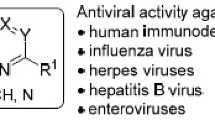Abstract
Substituted Schiff bases of l-amino-3-hydroxyguanidine (SB-HAG) were tested for the first time against noninfected T4 lymphocytes (CEM-6 cells) and the same cell line infected by HIV-1 in vitro. Twenty-one of 23 compounds at micromolar levels did not inhibit the growth of the noninfected T4 cells, suggesting minimal cytotoxicity. The antiviral effects of these compounds in a micromolar concentration range have been shown to be nonsignificant (<30%) against HIV-1. Three-dimensional parameter focusing of the physicochemical properties (i.e., log P and V w) and the marginal antiviral activities shows that the marginally active compounds lie in a region different from the inactive compounds. QSAR analysis of the two subsets shows that the cytotoxicity correlates well with the electronic and lipophilic parameters. The results of the QSAR analysis can serve as guidelines for further structural modification of this series of compounds to minimize the cytotoxicity against host cells.
Similar content being viewed by others
REFERENCES
P. E. Came and L. A. Caliguiri. Handbook of Experimental Pharmacology, Springer-Verlag, Berlin, Heidelberg and New York, 1982, Vol. 61, pp. 147–204.
R. H. Adamson. Hydroxyguanidine—a new antitumor drug. Nature 236:400–401 (1972).
A. C. Sartorelli, K. C. Agrawal, and E. C. Moore. Mechanism of inhibition of ribonucleoside diphosphate reductase by α-(N)-heterocyclic aldehyde thiosemicarbazones. Biochem. Pharmacol 20:3119–3123 (1971).
W. A. Carter. Selective Inhibitors of Viral Function, CRC Press, Cleveland, Ohio, 1973, p. 213.
A. E. Tai, E. J. Lien, M. M. C. Lai, and T. A. Khwaja. Novel N-hydroxyguanidine derivatives as anticancer and antiviral agents. J. Med. Chem. 27:236–238 (1984).
A. T'ang, E. J. Lien, and M. M. C. Lai. Optimization of the Schiff-bases of N-hydroxy-N′-aminoguanidine as anticancer and antiviral agents. J. Med. Chem. 28:1103–1106 (1985).
J. G. Cory, G. C. Carter, P. E. Bacon, A. T'ang, and E. J. Lien. Inhibition of ribonucleotide reductase and L1210 cell growth by N-hydroxy-N′-aminoguanidine derivatives. Biochem. Pharmacol. 34:2645–2650 (1985).
G. Weekbecker, E. J. Lien, and J. G. Cory. Effects of N-hydroxy-N′-aminoguanidine isoquinoline in combination with other inhibitors of ribonucleotide reductase on L1210 cells. J. Natl. Cancer Inst. 80:491–496 (1988).
E. J. Lien, P. H. Wang, B. Koneru, M. D. Trousdale, and M. D. Yorber. QSAR of the antiviral and cytotoxic effects of N-OH derivatives and preliminary data on HSV-1 in comparison with Ara-C and acyclovir. Acta Pharm. Jugosl. 39:87–96 (1989).
P. H. Wang, J. G. Keck, E. J. Lien, and M. M. C. Lai. Design, synthesis, testing and quantitative structure-activity relationship analysis of substituted salicylaldehyde Schiff-bases of 1-amino-3-hydroxyguanidine tosylate as new antiviral agents against coronavirus. J. Med. Chem. 33:608–614 (1990).
M. Matsumoto, J. G. Fox, P. H. Wang, P. B. Koneru, E. J. Lien, and J. G. Cory. Inhibition of ribonucleotide reductase, growth of human colon carcinoma HT-29 cells, and mouse leukemia L1210 cells by n-hydroxy-n′-aminoguanidine derivatives. Biochem. Pharmacol. 40:1779–1783 (1990).
P. Valenzuela, R. W. Morris, A. Foras, W. Levinson, and W. J. Rutter. Are all nucleotidyl transferases metalloenzymes? Biochem. Biophys. Res. Comm. 53:1036–1041 (1973).
W. Levinson, A. Foras, B. Woodson, J. Jackson, and J. M. Bishop. Inhibition of RNA-dependent RNApolymerase of Rous sarcoma virus by thiosemicarbazones and several cations. Proc. Natl. Acad. Sci. 70:164–168 (1973).
H. Sigel. Metal Ions in Biological Systems, Marcel Dekker, New York, Basel, 1973, Vol. 16, pp. 245–267.
S. Kit. Viral-associated and induced enzymes. Pharmacol. Ther. 4:501–585 (1979).
B. Oberg. Inhibitors of virus-specific enzymes. In C. G. Stuart-Harris and C. J. Oxford (eds.), Problems of Antiviral Chemotherapy, Academic Press, London, 1983. pp. 35–64.
E. Helgstrand and B. Oberg. Enzymatic targets in virus chemotherapy. Antibiot. Chemother. 27:22–69 (1982).
R. E. F. Matthews. Fourth report of the international committee on taxonomy of viruses. Intervirology 17:1–200 (1982).
J. S. Oxford, A. R. M. Coates, D. Y. Sia, K. Brown, and S. Asad. AIDS and AIDS-related infections: Current strategies for prevention and therapy. J. Antimicrobiol. Chemother. A (Suppl.) 23:9–27 (1989).
J. S. Oxford and D. D. Perrin. Inhibition of the paticle-associated RNA-dependent RNA polymerase activity of influenza viruses by chelating agents. J. Gen. Virol. 23:59–71 (1974).
J. S. Oxford and D. D. Perrin. Influenza RNA transcriptase inhibitores: Studies in vitro and in vivo. Ann. N.Y. Acad. Sci. 284:613–623 (1977).
P. H. Wang and E. J. Lien. Effects of different buffer species on partition coefficients of drugs used in quantitative structure-activity relationship. J. Pharm. Sci. 69:662–668 (1980).
O. S. Weislow, R. Kiser, D. L. Fine, J. Bader, R. H. Shoemaker, and M. R. Boyd. New soluble-formazen assay for HIV-1 cytopathic effects: Application on high-flux screening of synthetic and natural products for AIDS-antiviral activity. J. Natl. Cancer Inst. 81:577–586 (1989).
C. Hansch and A. Leo. Substituent Constants for Correlation Analysis in Chemistry and Biology, John Wiley & Sons, New York, Brisbane and Toranto, 1979.
A. L. McClellan. Tables of Experimental Dipole Moments, Rahara Enterprises, El Cerrito, CA, 1979, Vols. 2 and 3.
E. J. Lien (ed.). SAR: Side Effects and Drug Design, Marcel Dekker, New York and Basel, 1987, pp. 332–359.
H. Govers and P. de Voogt. Caculation of molecular volumes from molecular fragments via valence electron indices. Quant. Struct.-Act. Relat. 8:11–16 (1989).
J. G. Keck, P. H. Wang, E. J. Lien, and M. M. C. Lai. Inhibition of murine coronavirus RNA synthesis by hydroxyguanidine derivatives. Virus Res. 14:57–64 (1989).
A. W. Tai. Design of Novel 1-Amino-3-hydroxyguanidine Derivatives Antiviral and Anticancer Agents, Ph.D. dissertation, USC, Los Angeles, 1982.
P. H. Wang. Design, Synthesis, Testing and QSAR Analysis of Substituted Salicylaldehyde Schiff-Bases of 1-Amino-3-hydroxyguanidine Tosylate as New Antiviral Agents Against Coronavirus, Ph.D. dissertation, USC, Los Angeles, 1989.
Author information
Authors and Affiliations
Rights and permissions
About this article
Cite this article
Wang, PH., Hui, M.B.V., Nandy, P. et al. Quantitative Structure–Activity Relationship (QSAR) Analysis of the Cytotoxicities Of Aminohydroxyguanidine Derivatives and Their Antiviral Activities in Vitro . Pharm Res 8, 1006–1012 (1991). https://doi.org/10.1023/A:1015852907149
Issue Date:
DOI: https://doi.org/10.1023/A:1015852907149




